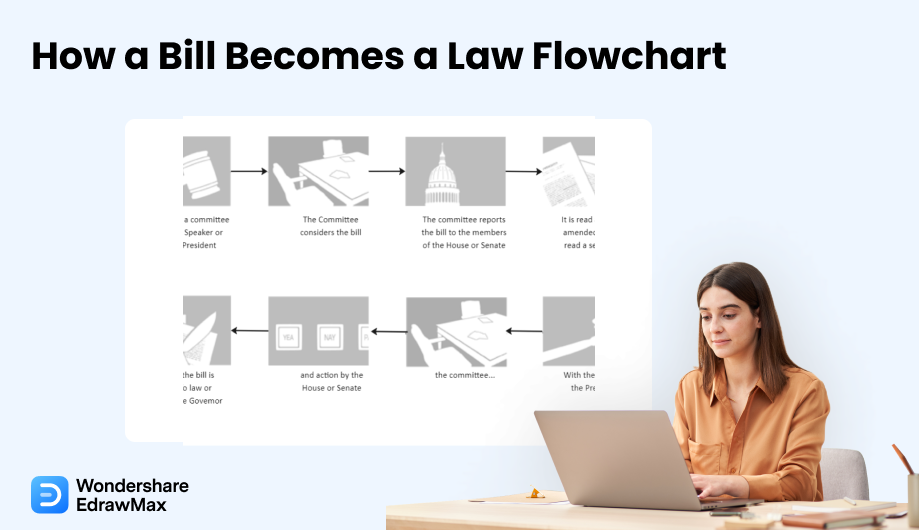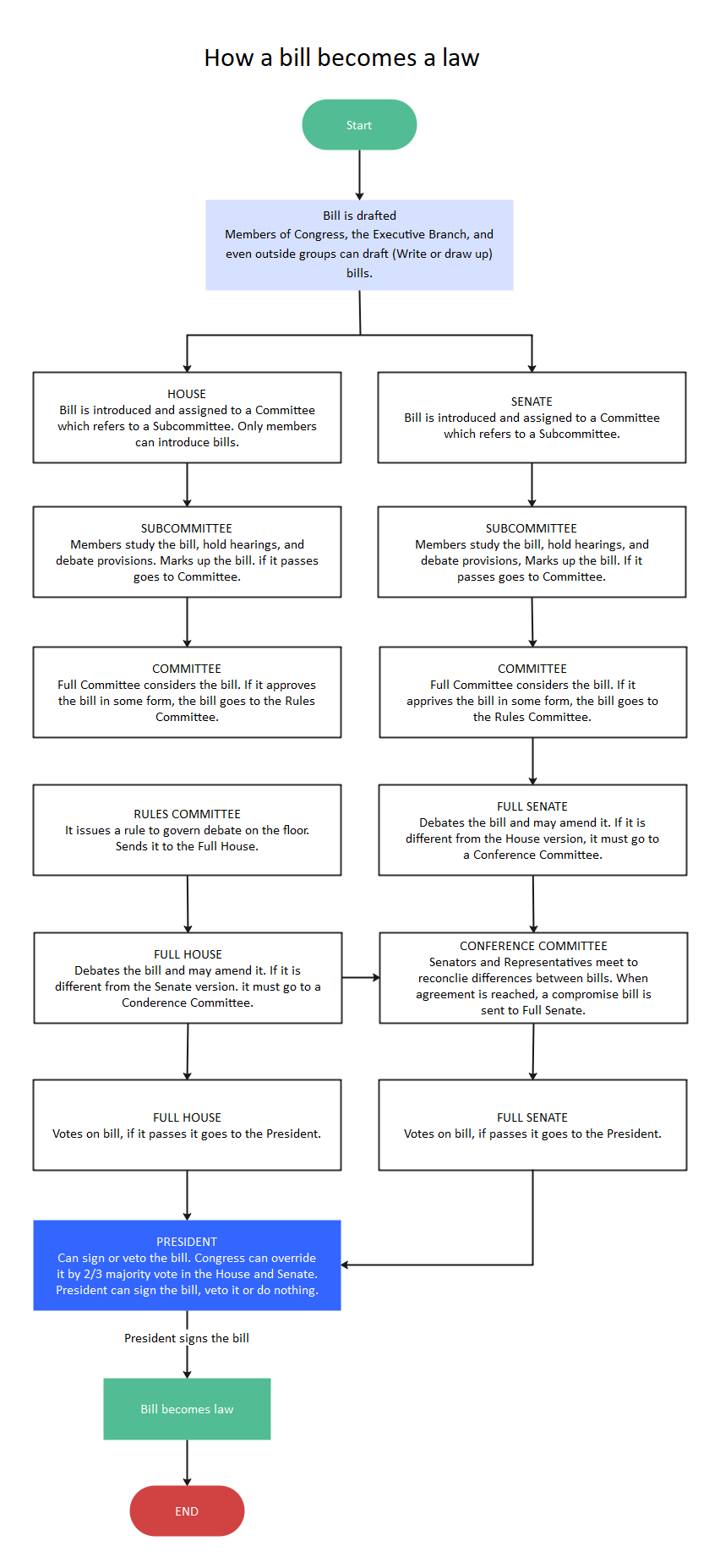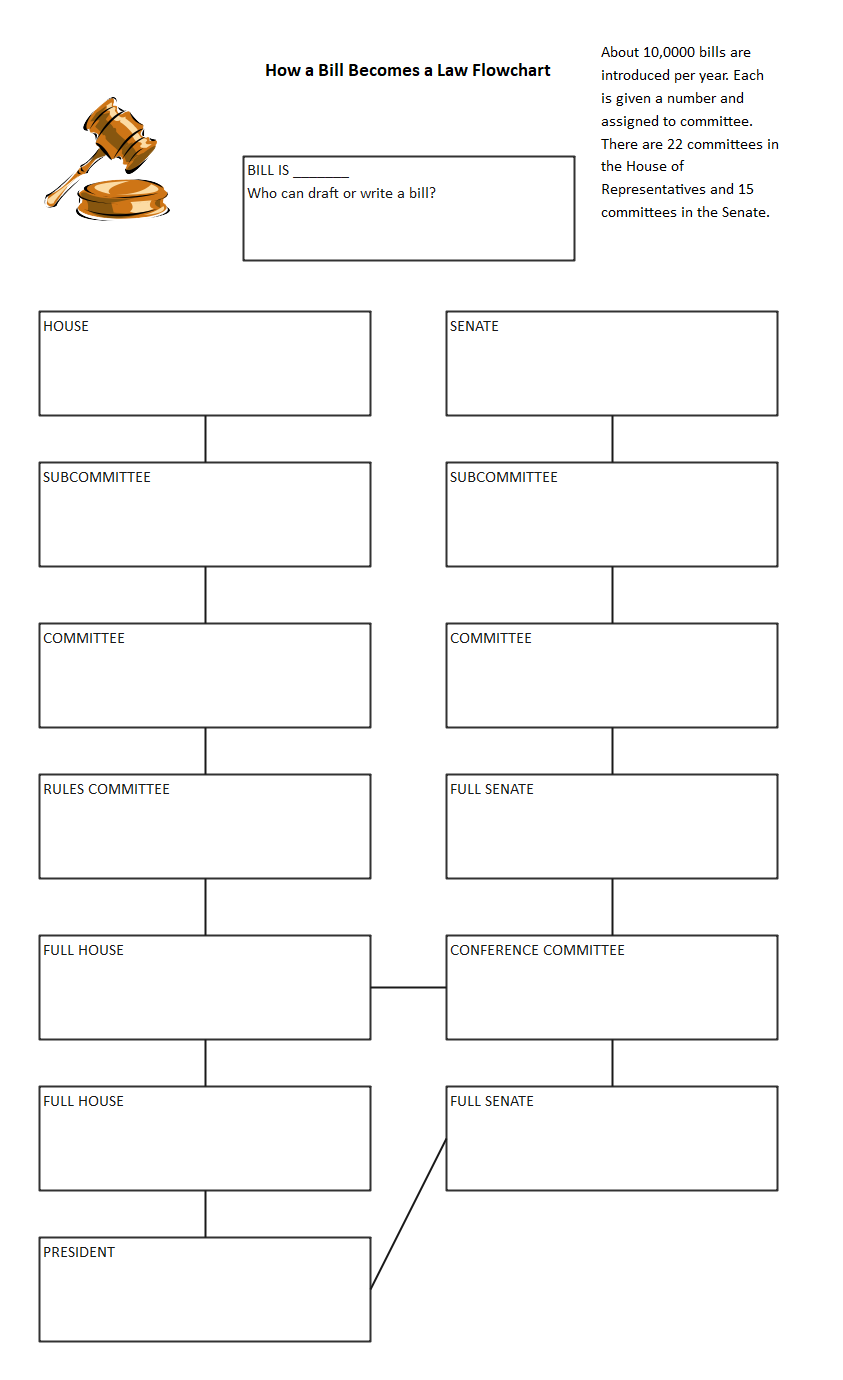How a Bill Becomes a Law Flowchart
Edraw Content Team
Do You Want to Make Your Flowchart?
EdrawMax specializes in diagramming and visualizing. Learn from this How a Bill Becomes a Law Flowchart complete guide to know everything about the progress of How a Bill Becomes a Law. Just try it free now!
Lawmaking is a technical process. It is a common practice in politics that the bill needs to pass through its initial stages before it becomes law. A thorough discussion and debate help avoid loopholes and unintended consequences. If you are interested in how a bill becomes law flowchart, this can help.
The legislative process is complex, so it is important to visualize how bills make their way through the House and Senate. Understanding it starts with knowing what happens before it passes. Read on to learn how laws get passed and what a flowchart template can do for you.

1. The Process of a Bill Becoming a Law
Bills become law by passing through the legislative process. An introduction, debate, and passage make up a significant part of the process. This eight-step guide will answer your online question on "how a bill becomes law flowchart."
Step 1: Draft the Bill
The legislation begins as soon as a senator or assembly member writes a bill. Other lawmakers can co-sponsor it if they agree with its purpose. It is a way to bring attention to and show that there is support for it.
Step 2: Introduce the Bill
After that, a member of Congress introduces the bill. They will submit a copy of the bill, give it an official number, and include the sponsor's name. If a Representative sponsors the bill, it goes to the House. A senator must sponsor the bill to introduce it in the Senate. There can't be any action on a bill before 30 days have passed.
Step 3: Send the Bill to the Committee
The parliamentarian for the House or Senate usually makes the final decision about the referral. Policy committees review bills based on their subject expertise. Each of these committees has members from both parties and does research, holds hearings, and votes. They also make recommendations to their respective chambers on critical issues.
Step 4: Assessment of the Bill by the Subcommittee
Next, the bill goes under review and discussion by the subcommittee assigned by the chairperson. Both Houses of Congress can amend and change it before voting on it. Bills in both chambers may have amendments attached to them, which can significantly change their content.
Step 5: Hearing of the Bill by the Full Committee
The full committee receives the results from the subcommittees. In a markup session, the committee will make changes and additions. If there are significant changes to the bill, the committee might require a clean bill containing the changes.
If there are any committee amendments, the chamber must accept, alter, or reject them before voting. A bill has to get a majority vote in the committee. Unless a committee recommends a bill to Congress, it expires.
Step 6: Floor Debate Issued by Rules Committee
The bill goes to the floor after the committee approves it. This new bill will replace the previous one with a new number.
- Full House
Before being debated on the floor of the House, most proposals must go to the Rules committee. The committee decides on the rules that will control how the House will debate the bill. The committee decides how much time to give each participant. There are no riders; all bill amendments must be meaningful.
- Full Senate
The debate is open-ended unless there is cloture. Discussions are open to members for as long as they want. It is possible to propose entire legislation as an amendment to another bill. In a debate without cloture, senators can try to kill a bill by talking about it to death.
Step 7: Conciliation of the Conference Committee
The Conference Committee handles bills if the House and Senate adopt different versions. A Conference Committee reviews most of the significant legislation. Reps from both Houses get together to resolve disagreements. It's usually a committee of seniors selected by the chairpersons from the committee that deliberated the bill first.
Unless the committee member agrees, the bill dies. Each chamber receives a conference report if the committee members resolve their differences. Each should approve the document before it can get to the next step.
Before the bill reaches its final stage and becomes a law, committees, subcommittees review it, and sometimes even special interest groups. If approved, the bill moves on to the next step of its legislative process.
Step 8: Decision of the President
Then, if both Houses approve the bill in the same version, the president signs it into law or vetoes it. The bill gets signed into law if there is approval given to it. If Congress is in session and the president doesn't act, it systematically becomes law.
The bill does not become law if Congress adjourns before the 10-day mark and the president has not signed it, and Congress may not override it by voting. In addition, if the president vetoes a bill, it must have approval from two-thirds of each House to become law.
2. Visualize How a Bill Becomes a Law Flowchart
Congress reads and considers any bill before it goes to the president. Although this sounds like the easiest part, there is more to it. We know it is confusing and time-consuming to figure out how a bill becomes law. Flowcharts can show how bills move through the legislative process and eventually become laws.
Below are some how a bill becomes a law flowchart templates for your use in class, reading, or if you need one for work.
How a Bill Becomes a Law Flowchart Template
If you're looking online for "how a bill becomes a law flowchart," this template should hold your attention. It is a simple way to explain the complex process of passing a bill. This flowchart template makes it easy for viewers to understand.
How a Bill Becomes a Law Flowchart Blank Template
If you're teaching about legislation, you are probably finding online "how a bill becomes a law flowchart blank." Below is a worksheet you can use to get started. You can use this flowchart template to teach your students or use it for quizzes.
EdrawMax is the diagramming and data visualization tool that makes your ideas come alive. It has an impressive library of 26,000+ symbols and 1500+ templates, making it one of the most versatile diagram tools.
In addition, EdrawMax provides a collaborative and engaging experience for teamwork on an infinite canvas. You can also save time and have your visual ready in minutes because EdrawMax makes it easy to export to different file formats. If you want it to reach more people, you can also share your visual plans on social media with EdrawMax.
3. Frequently Asked Questions About a Bill and Law
- How are Bills Different from Laws? represents the start/end.
A bill is a legislative proposal in the U.S. It expires if lawmakers don't vote for it or the executive rejects it. Without authorization, it doesn't become law.
So only after a bill gets enacted and signed that it becomes law. Statute or Act of Congress is another term for law. It is a set of regulations put into action with the aid of law enforcement.
- What Happens to a Bill That Dies?
Any bill that is not approved and made law before the conclusion of the second congressional session "dies." The next Congress can reintroduce a dead bill with a new bill number. It may be necessary for a researcher to follow several related measures over successive Congresses. Later laws on the same subject may refer to materials created in past Congresses.
- What 4 Things Can Happen to a Bill?
Following its submission to the president for signing, a bill may experience the following outcomes:
- Bills become laws when the president signs them.
- If a bill has no signature in ten days and Congress is in session, it becomes law.
- The bill does not become law if Congress adjourns before the 10-day mark and the president has not signed it (Pocket Veto.)
- The bill goes back to Congress with a message explaining why the president vetoed it. With a vote from two-thirds of the present members, the chamber that first proposed the law may petition to override the veto. Bills become law if both chambers override vetoes.
- What Elements Does a Bill Contain?
A bill must include critical elements, such as a title, an enacting clause, sections altering and repealing laws, and an effective date.
The essential elements of a bill include the title, enacting clause, clause, and number. Other bill elements are optional. It comprises the interpretation provisions and the preamble.

Flowchart Complete Guide
Check this complete guide to know everything about flowchart, like flowchart types, flowchart symbols, and how to make a flowchart.
You May Also Like
What is Mesh Topology
Knowledge
Star Topology Diagram Complete Guide
Knowledge
WBS Chart Complete Guide
Knowledge
Matrix Org Chart Complete Guide
Knowledge





